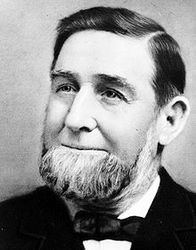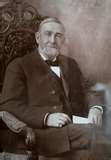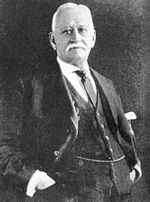EARLY CHRONOLOGY
-1870, Captain Lorenzo Dow Baker buys 160 bunches of bananas in Jamaica for a shilling per bunch and sells them in Jersey City for $2 each. After this success he and the Bostonian entrepreneur Andrew Preston join efforts to develop a banana market in Boston.
-1871, Kieth travels to Costa Rica to work on a railroad project his uncle Henry Meiggs was building for the national government.
-1873, Kieth, when looking for cheap food for his workers, plants banana trees adjacent to his railroad tracks.
-1870, Captain Lorenzo Dow Baker buys 160 bunches of bananas in Jamaica for a shilling per bunch and sells them in Jersey City for $2 each. After this success he and the Bostonian entrepreneur Andrew Preston join efforts to develop a banana market in Boston.
-1871, Kieth travels to Costa Rica to work on a railroad project his uncle Henry Meiggs was building for the national government.
-1873, Kieth, when looking for cheap food for his workers, plants banana trees adjacent to his railroad tracks.
Andrew Preston Lorenzo Dow Baker Minor C. Keith
-1885, Baker and Preston establish the Boston Fruit Company as Americans increase their demand for fruit. Preston takes charge of tropical enterprises while Baker controls management in Boston.
-1890, After facing incredible difficulties, Keith finishes the railroad from San Jose to Puerto Limon. However, the low number of passengers using the train made it unprofitable. Keith decides to use it to export bananas from the plantations he had created in the early 1870s. The first shipments proves to be a great success.
-1897, Keith purchases a 50% of the share in the Snyder Banana Co. which produces bananas on 6,000 acres at Bocas del Toro, Panama.
-1899, Keith's bank, Hoadley and Company, goes bankrupted. Keith loses $1.5 million. In order to solve his difficult financial situation, Keith goes to Boston and arranges with Andrew Preston a merger of his company and the Boston Fruit Company. Prior to the negotiation Preston, Baker, and Keith control 75% of the banana market in the U.S.
from United Fruit Historical Society. http://www.unitedfruit.org/ (accessed June 18, 2010).
-1890, After facing incredible difficulties, Keith finishes the railroad from San Jose to Puerto Limon. However, the low number of passengers using the train made it unprofitable. Keith decides to use it to export bananas from the plantations he had created in the early 1870s. The first shipments proves to be a great success.
-1897, Keith purchases a 50% of the share in the Snyder Banana Co. which produces bananas on 6,000 acres at Bocas del Toro, Panama.
-1899, Keith's bank, Hoadley and Company, goes bankrupted. Keith loses $1.5 million. In order to solve his difficult financial situation, Keith goes to Boston and arranges with Andrew Preston a merger of his company and the Boston Fruit Company. Prior to the negotiation Preston, Baker, and Keith control 75% of the banana market in the U.S.
from United Fruit Historical Society. http://www.unitedfruit.org/ (accessed June 18, 2010).
In Boston in 1899 three entrepreneurs came together to form one the first and largest multinational conglomerates of the early 20th century. Minor C. Keith, Andrew Preston and Lorenzo D. Baker formed the United Fruit Company on the back of Keith’s already vast holdings.
"At the inception of United Fruit Keith already owned plantations in Columbia and in the Caribbean, controlled a railway network in Central America and controlled the banana market in the Northeast of the United States."
Bucheli from the Business History Review
"At the inception of United Fruit Keith already owned plantations in Columbia and in the Caribbean, controlled a railway network in Central America and controlled the banana market in the Northeast of the United States."
Bucheli from the Business History Review

courtesy Bing images
In this same year United Fruit, (now Chiquita) decided to capitalize on Keith’s holdings in Columbia and started sending its ships (Great White Fleet) to the remote region of Magdelena. With the introduction of refrigerated shipping United Fruit came to dominate agrarian economics in Central America, the Caribbean and Columbia, but there were signs of trouble on the horizon, if not for the United Fruit Company than certainly for the nations that hosted them. In 1903 A Columbian separatist state called Panama declared independence from their mother country. Backed by US might Panama granted the United States the right to construct the now famous canal. This caused many issues for the UFC in Columbia as the US Navy had to be deployed to the Columbian coast to protect Americans and prevent any backlash against Panama.
And again trouble raises it’s head in 1918, “The workers of the banana plantations in Northern Colombia go on strike. They demand six-day labor week and eight-hour labor day plus health care. The strike does not succeed." Bucheli from Essays in Economic and Business History
And again trouble raises it’s head in 1918, “The workers of the banana plantations in Northern Colombia go on strike. They demand six-day labor week and eight-hour labor day plus health care. The strike does not succeed." Bucheli from Essays in Economic and Business History
This remote farming region (Magdelena area) was poorly equipped to deal with the massive agricultural injection it was now receiving.
As one scholar puts it, “Its [UFC] arrival represented the start of a process that changed Magdelena forever. Government neglects had made Columbia one of the most economically backward regions but it underwent dramatic changes with the arrival of United Fruit, which developed an infrastructure for producing bananas for export to the United States.” Stiffler from Banana Wars
As one scholar puts it, “Its [UFC] arrival represented the start of a process that changed Magdelena forever. Government neglects had made Columbia one of the most economically backward regions but it underwent dramatic changes with the arrival of United Fruit, which developed an infrastructure for producing bananas for export to the United States.” Stiffler from Banana Wars
So how does a company that produces a perishable food item become one of the focal points of US foreign policy in Latin America?
"In a word size, United fruit owned vast land in Central America, the Caribbean and South America, employed millions of people, dictated local government, and control of the railways."
May from the United Fruit Company in Latin America
This control over land and railways causes a lot of friction between United Fruit and the Colombian national government.
“In 1925 it (UFC) operated 176 miles of track, 91 of which constituted the main line to Fundacion, and 81 miles of branch lines within the plantations. By 1928 UFC was exporting 64 million bunches of bananas, worth 35 million dollars, per year to the US alone. Bananas accounted for 53% of the total US imports from the Caribbean and Colombia."
Palmer from Economic Geography
"In a word size, United fruit owned vast land in Central America, the Caribbean and South America, employed millions of people, dictated local government, and control of the railways."
May from the United Fruit Company in Latin America
This control over land and railways causes a lot of friction between United Fruit and the Colombian national government.
“In 1925 it (UFC) operated 176 miles of track, 91 of which constituted the main line to Fundacion, and 81 miles of branch lines within the plantations. By 1928 UFC was exporting 64 million bunches of bananas, worth 35 million dollars, per year to the US alone. Bananas accounted for 53% of the total US imports from the Caribbean and Colombia."
Palmer from Economic Geography



